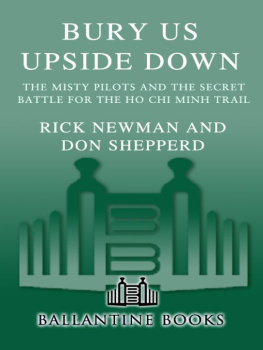Table of Contents
Praise for BURY US UPSIDE DOWN
With its great in-the-cockpit stories of the first jet-fighter combat forward air controllers, Bury Us Upside Down is an incredible account of how it all started. The reader will feel the G forces, the strain of avoiding ground fire, the satisfaction of a completed rescue, the black humor of combat-hardened pilots, and the effects on the families of those who didnt return. But most of all the reader will feel proud that America can produce such men. MARK BERENT,
combat pilot and author of the bestselling Rolling Thunder series
Retired Maj. Gen. Don Shepperd... and writer Rick Newman paint a complete picture of one of the most harrowing assignments pilots undertook during the Vietnam War.... [ Bury Us Upside Down ] makes current-day battle watchers think twice about the risk and sacrifice pilotsand any soldier, airman, sailor, or marineencounter when they put on the nations uniform. National Guard magazine
Rip that Nintendo out of your kids hands and hand him Bury Us UpsideDown ! This outstanding book will give him insight into what real aerial combat, flown by real heroes, is like. Undoubtedly the best book of its type,... [ Bury Us Upside Down ] is the truth writ bold and simple the story of the men who fought the war flying the toughest missions imaginable, and their families. It is a book of heroes, and just reading it gives you insight into what a true hero feels. WALTER J. BOYNE,
bestselling author of over fifty aviation books and former director
of the National Air and Space Museum, Smithsonian Institution
Journalist Rick Newman and former Misty pilot Don Shepperd bring the reader into the bases, bars, and jets where the pilots lived and worked, let off steam, and came to terms with a war against a foe that would not give up.... Readers with a sure grasp of the war will lap up every assault and acronym. At heart, though, this is a story of heroes, fliers, and families. Milwaukee Journal Sentinel
Bury Us Upside Down is a superb book about pilots in a tough mission in a tough war. It is perhaps the best view of aerial combat ever written. You are put in the cockpit with the pilots who flew these missions as it happens. The result is mesmerizing. When you pick up this book, youll have trouble putting it down, and you will never forget its powerful testimonies of combat aviators.
Gen. Ronald Fogleman, USAF (Ret.), former Air Force chief of staff
FOREWORD
By Senator John McCain
Wars are painful experiences, not only for the soldiers, sailors, airmen, and Marines who take part, but also for their families and the countries that send them. It has become all too common to focus exclusively on combat and the stories of those who fight, so it is often easy to forget wars tragic effectson the families of those involved and on the innocentsthe citizens on both sides who also bear the burden. The Vietnam War, Americas longest and arguably most painful war, was a tragedy for two countries, theirs and ours.
Bury Us Upside Down is a unique book because it covers the full gamut of warfarenot only the stories of those at war, but of their families, their countries, their governments, and their politicians. In short, it is a well-researched book about warriors and the effects war has on a country. I have seen these effects of war on my family, on my nation, and ultimately on myself. Several of the men in this book were my companions in prison. Through their eyes you also will experience these effects.
Though I entered the theater earlier, my Vietnam story truly begins on October 26, 1967. In a few moments my life and future were inexorably altered as my aircraft was hit by a Soviet-made surface-to-air missile. While ejecting from the stricken aircraft, I broke both arms and a leg, and soon found myself surviving for over five years in the infamous Hanoi Hilton prison in downtown Hanoi.
It was during my years as a prisoner of war that I first encountered the Misty warriors featured in the following pages. Solitary confinement, denial of medical attention, and torture became the standard treatment for American POWs. As I endured this new way of life, I met Maj. Bob Craner. While I was in solitary confinement, Bob occupied the cell next to mine. We became acquainted through the tap code described later in the book. This clandestine means of communication, performed by tapping on the walls of our cells, enabled us to become acquainted. Although I could not hear his voice or see his face, he gave me encouragement in times of despair, and strength in times of weakness. I only hope I was able to provide him with some comfort through those hellish days.
During my confinement I learned of Maj. Bud Day, the first Misty commander, who was subsequently awarded the Medal of Honor for his actions while a POW. His story of survival, escape, recapture, and torture during a two-week escape attempt is without compare in excitement and intrigue. I also encountered Guy Gruters, shot down twice, the second time with Bob Craner. Guys story of desperately attempting to save the life of fellow warrior Lance Sijana Medal of Honor recipient and the namesake of Sijan Hall at the Air Force Academyis heartbreaking. You will also read of P. K. Robinson. Although we met just before our return on the Freedom Flights, our short time together and shared experiences as fellow POWs will forever cause me to consider him a close brother and companion.
This wonderful book will introduce you to these and other Misty warriors157 of them flying two-seat USAF F-100 fighters as fast FACs, forward air controllers, seeking out targets for bomb-dropping fighters over North Vietnam. It was an impossibly dangerous mission for which they paid the ultimate price. This book goes beyond the normal war story. It proves to be engaging and accessible to fighter pilot and civilian alike. You will be able to understand their story and the story of so many others who never returned home.
An extraordinary book that adds a critical volume to the literature about the Vietnam experience, Bury Us Upside Down serves to remind us of why war is such a serious endeavor. We would do well as a nation to heed the lessons and messages it contains. I would like to personally thank Don and Rick for their efforts in bringing this story to light and celebrating all the heroes from Americas longest war.
INTRODUCTION
The lights of Baghdad burned bright in the background as Pepe, an A-10 Warthog pilot, peered through night-vision goggles into the desert below. It was the night of April 6, 2003. U.S. Army and Marine units had been tearing through the desert for a week in a race to capture the Iraqi capital and depose Saddam Hussein. They were finally approaching the outskirts of Baghdad and would attack into the city the next morning.
Pepe was an A-FAC, an airborne forward air controller who scouted for surface targets that could be destroyed from the air before U.S. ground forces ever encountered them. His job was to scour a thirty-by-thirty-mile kill box south of Baghdad, searching for Iraqi Republican Guard tanksa last line of defense, and a dangerous one, against the invading Americans.

